|
Special Features





Image Libraries


|
|
Blog
DC is adding green-painted bike lanes left and right, which is great news, but the District is way behind other cities in another type of painted pavement that’s beginning to sweep across America: red-painted bus lanes.
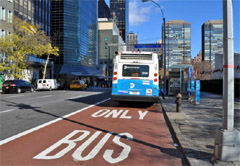 |
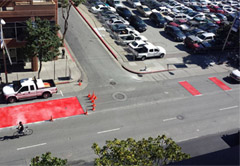 |
Red-painted bus lanes in New York (left) and San Francisco (right).
Photos from NYDOT and Reddit user freedenizen. |
The idea behind red-painted bus lanes is exactly the same as green for bikes. It’s a clear signal for car drivers to stay out, so there’s no excuse for illegally driving in a non-car lane. San Francisco even uses dashed red paint to indicate where cars are allowed to cross bus lanes, exactly how DC uses green dashes for crossings.
In addition to New York and San Francisco, red-painted bus lanes will also soon pop in Seattle and Chicago.
Why not here? For one, obviously, DC doesn’t have many bus lanes. Plans for bus lanes on 16th Street and H & I Streets are stalled, and although the K Street Transitway is moving forward as part of the crosstown streetcar, there’s no opening date in sight.
But DC does have one bus lane on the ground right now that could benefit from red paint. 7th Street NW in Chinatown, directly in front of the Verizon Center. 7th Street has signs and pavement markings indicating it’s a bus lane, but it’s never enforced, and so many cars use the lane that you’d never know they’re not supposed to be there.
If DDOT is serious about keeping the 7th Street bus lane then red paint could be a way to make it work. If not, paint is still worth exploring on 16th, H & I, and K, if bus lanes there ever actually happen.
Average Rating: 4.6 out of 5 based on 196 user reviews.
May 15th, 2014 | Permalink
Tags: bike, BRT, bus, transportation

This is what 16th Street looks like on a typical weekday morning. Good luck navigating it, as either a bus rider or car driver.
Streamlining this mess of buses with a transit lane could speed up traffic for everyone.
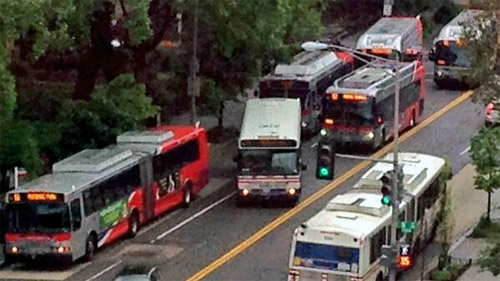
Bus bunching on 16th Street. Photo by Kishan Putta.
More than half of all people traveling on 16th Street at rush hour use the bus. It’s DC’s most successful bus corridor. But that success comes with a down side: There are so many buses that they bunch into bus traffic jams.
That’s a problem for both bus riders and car drivers. Instead of being able to catch a bus every two minutes, transit riders have to wait a long time for a clump of several buses to arrive all together, almost like a single long train. Most of the buses are full, but eventually one near the end of the “train” may have enough room for more passengers to board.
That’s inefficient, slows down the line, reduces overall capacity, and adds unnecessary operating expense.
And it’s just as bad for car drivers. Imagine being stuck behind that clump of buses in a car. That’s a traffic jam, no two ways about it.
And this is why a bus lane on 16th Street could potentially help everyone. If that bus traffic jam can be streamlined into a bus lane, buses will move faster and stay better organized, and cars won’t have to contend with roaming clumps of disorganized buses spilling into every lane.
Theoretically DDOT should be able to add a bus lane without sacrificing any car lanes. But even if sacrificing a car lane is necessary, that still may improve car traffic simply by virtue of eliminating bus jams.
It’s worth trying.
 Cross-posted at Greater Greater Washington. Cross-posted at Greater Greater Washington.
Average Rating: 4.5 out of 5 based on 257 user reviews.
May 1st, 2014 | Permalink
Tags: BRT, bus, roads/cars, transportation

|
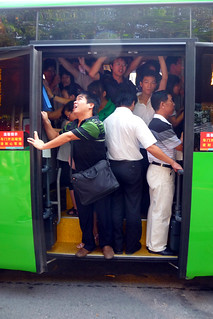
Overcrowded bus.
Photo by dcmaster on flickr. |
More and more people are riding the bus in DC. That’s great, but it’s also straining the system to its limits. Experts from DDOT and WMATA will discuss how to make buses work better for more people at a free panel on Wednesday evening.
Buses come every couple of minutes on WMATA’s busy 16th Street line. But it’s not enough. Rush hour passengers often watch bus after bus pass by, too jam packed to allow even one more person on board. Other lines face similar problems, or soon will.
What can we do? Simply adding more buses may not work, because there are so many buses already on 16th Street that they bunch together, forming long pseudo-trains where multiple buses all come at the same time. Even if the last bus is empty, bunching like that slows down the entire line for everyone; waiting passengers wait longer, and moving buses move slower.
Meanwhile, WMATA’s central DC bus storage barn doesn’t have any extra room for new or bigger buses, so even adding more articulated buses would be difficult, expensive, and take years of planning.
Streetcars could increase capacity, but they’d take even longer to implement. And they work better for shorter trips on commercial streets anyway, as opposed to the longer commute trips common on 16th Street.
Bus lanes are a possibility, but repurposing car lanes for transit takes a lot of political courage. So far leaders in DC haven’t been willing to take that leap.
What’s left? What can we do? Or can longer buses or bus lanes actually work?
Come to 1701 16th Street NW on Wednesday from 6:00 – 8:00 pm to hear experts weigh in. Panelists include DC Councilmember Mary Cheh, WMATA’s head bus planner Jim Hamre, DDOT transit planner Sam Zimbabwe, and former New York City Director of Transit Planning Joseph Barr.
RSVP with the Coalition for Smarter Growth.
Average Rating: 5 out of 5 based on 282 user reviews.
April 29th, 2014 | Permalink
Tags: bus, events, transportation

|
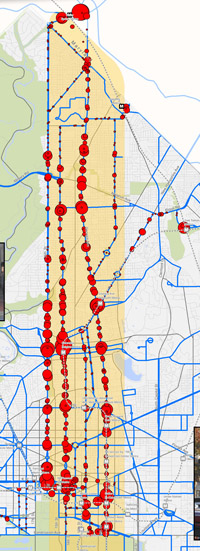
Map from DDOT. |
Every circle on this map is one bus stop. The larger the circle, the more riders get on or off at that stop.
The map shows where riders are going on WMATA’s busy 16th Street, 14th Street, and Georgia Avenue lines, plus a couple of smaller routes in the same part of town.
It’s a fascinating look at transit ridership patterns in DC’s densest corridor. And it correlates strongly with land use.
Georgia Avenue is a mixed-use commercial main street for its entire length. Thus, riders are relatively evenly distributed north-to-south.
16th Street, on the other hand, is lined with lower density residential neighborhoods north of Piney Branch, but is denser than Georgia Avenue south of there. It’s not surprising then that 16th Street’s riders are clustered more heavily to the south.
14th Street looks like a hybrid between the two, with big ridership peaks south of Piney Branch but also more riders further north of Columbia Heights. 14th Street also has what appears to be the biggest single cluster, Columbia Heights itself.
DDOT produced this map as part of its North-South Corridor streetcar planning. It’s easy to see why DDOT’s streetcar plans are focusing on 14th Street to the south and Georgia Avenue to the north.
Likewise, this illustrates how a 16th Street bus lane south of Piney Branch could be particularly useful.
 Cross-posted at Greater Greater Washington. Cross-posted at Greater Greater Washington.
Average Rating: 4.8 out of 5 based on 195 user reviews.
April 7th, 2014 | Permalink
Tags: BRT, bus, streetcar, transportation

Howard and Anne Arundel Counties have teamed up to create a new transit agency that will take over bus operations in the two Maryland counties.
The new agency will be called the Regional Transportation Agency of Central Maryland (RTA). It will replace the Howard Transit and Central Maryland Regional Transit bus networks that currently operate in the area.

Existing CMRT bus. Photo from CMRT.
The decision to consolidate services seems aimed primarily at saving money. A single agency will combine its overhead costs, reducing operating expenses by an estimated 17%. That will save about $2 million per year.
It’s unclear whether that $2 million will be reinvested towards improved transit service, or simply redirected back to each county’s general fund. Howard and Annue Arundel have the weakest transit coverage in the Maryland suburbs, so they could certainly use improved service.
Annapolis Transit may also opt to join the newly consolidated agency, but hasn’t yet agreed.
Average Rating: 4.5 out of 5 based on 225 user reviews.
March 31st, 2014 | Permalink
Tags: bus, transportation

I’ve definitely had the conversation depicted on this ad, which is hanging in a Metro station. It’s like WMATA doesn’t get me at all.
Anybody else?
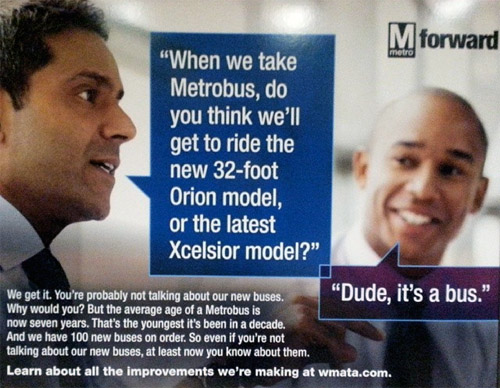
 Cross-posted at Greater Greater Washington. Cross-posted at Greater Greater Washington.
Average Rating: 4.7 out of 5 based on 164 user reviews.
January 31st, 2014 | Permalink
Tags: bus, transportation

Transit advocates want bus lanes on 16th Street, and DDOT’s latest moveDC plans call for them, but at a recent meeting, Ward 4 Councilmember and mayoral candidate Muriel Bowser expressed skepticism that they’re possible.
Here’s how they might be able to work.
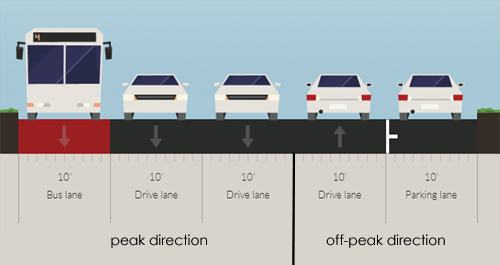
Image created using Streetmix.
Yes, 16th Street really is that wide
16th Street is 50 feet wide, curb to curb, for pretty much its entire length. But those 50 feet are arranged in three different configurations, depending on the location.
North of Arkansas Avenue, 16th Street has two lanes in each direction with a raised median down the middle. The presence of that median makes this section the hardest to change.
Between P Street and W Street, 16th Street only has four lanes and lacks a median. But it’s still 50 feet wide. The four lanes are just excessively wide.
Between Arkansas Avenue and Park Road, 16th Street’s same 50-foot width is split into five 10′ lanes. This section is the most informative, and illustrates how a bus lane might fit in.

Image created using Streetmix.
Flexible lanes are the key
There are many demands on 16th Street. Residents want on-street parking. Drivers want two lanes open for cars in each direction. Transit riders want bus lanes.
Ideally we could accommodate all that on one street and still keep it pedestrian-friendly. But with exactly 50 feet to work with, compromises are necessary.
At off-peak times, both car and bus traffic on 16th Street moves pretty well with just one lane in each direction, leaving the curbside lanes for on-street parking. It’s only at rush hour that more lanes are really necessary.
The solution so far has been to restrict parking at rush hour, allowing the curbside lane to carry traffic at peak times. But north of Arkansas Avenue and south of W Street, where 16th Street is configured with only four total lanes, that solution leaves out a dedicated bus lane.
Using the five lane configuration, however, allows the curbside lane to become a bus-only lane at rush hour, while leaving the center reversible lane as a 2nd general traffic lane. For the most part, everybody gets what they want.
Theoretically, DDOT could apply this configuration to the existing five lane stretch of 16th Street more or less immediately. And although the median north of Arkansas Avenue is hard to change, restriping the four lane section south of W Street should be relatively easy.
And while a peak-period bus lane between P Street and Arkansas Avenue might not be as great as a full busway all the way from Silver Spring to K Street, it would still be one heck of an improvement over current conditions.
Will this actually happen?
Of course, what’s theoretically possible and what’s practically achievable aren’t always the same. DDOT would need to study this much more closely before implementing it.
One potential holdup is that 10 feet is awfully narrow for a bus lane. Usually bus lanes are 11 or even 12 feet wide. But 10-foot lanes seem to be working now between Park and Arkansas, so why not further south as well?
A pilot project on the existing five lane section might help determine if this is a workable configuration.
Dupont Circle ANC Commissioner Kishan Putta suggested a pilot project in December. According to Putta, DDOT staff “said they were interested.” That’s certainly encouraging.
As for Bowser, she sent this statement in an email to Ken Archer, who had tweeted about the news:
“I never said I don’t support bus lanes. As I recall, I believe I said I don’t think it would work on 16th Street; though I was not responding to any specific proposal. My response was based on my many years of observing traffic patterns on the corridor– but not actual data. I went on to say, which has unfortunately not shown up in your tweets, that signal prioritization is a strategy on the books, with funding that needs to be implemented. As I mentioned to you, I’m happy to review and consider an actual dedicated bus lane proposal that proves to help the most people.”
 Cross-posted at Greater Greater Washington. Cross-posted at Greater Greater Washington.
Average Rating: 5 out of 5 based on 248 user reviews.
January 23rd, 2014 | Permalink
Tags: BRT, bus, transportation

Starting this week, WMATA is adding new service to several of the most important bus routes throughout DC, Maryland, and Virginia. Many lines will see more frequent buses, especially during nights and weekends.

Map highlighting routes with added service.
In DC, more frequent weekend & evening buses are now running on nearly all of the major trunk bus lines, including 16th Street, 14th Street, Georgia Avenue, Pennsylvania Avenue, H Street, and U Street / Florida Avenue. Perhaps most importantly, Georgia Avenue’s route 79 MetroExtra service now runs on Sundays.
In Maryland, the New Hampshire Avenue, Georgia Avenue, and National Harbor lines are getting more buses. For Virginia, the biggest improvements are along Leesburg Pike and Little River Turnpike.
WMATA modifies its bus service a few times each year, but this round is particularly important because of DC’s WMATA’s Better Bus program, which is gradually improving the most important bus lines in the District.
The complete list of service changes includes dozens of changes all over the region. Most of them are positive, although a few routes here and there will see decreased service.
 Cross-posted at Greater Greater Washington. Cross-posted at Greater Greater Washington.
Average Rating: 4.9 out of 5 based on 162 user reviews.
December 30th, 2013 | Permalink
Tags: bus, transportation

Today in transit nerdery, take a look at this Capital Transit articulated bus from 1948.
According to the original description, this is a demonstration run of a bus model Capital Transit never actually used for passengers. The photo shows the Calvert Street turnaround, which is still used today.
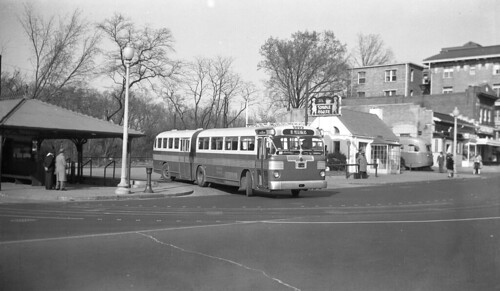
Original photo by Robert S. Crockett. Copied by flickr user rockcreek.
Average Rating: 4.8 out of 5 based on 249 user reviews.
November 26th, 2013 | Permalink
Tags: bus, history, transportation

Every day 33 bus routes converge on H and I Streets in downtown DC, making it the busiest bus corridor in the DC region. According to a WMATA report, a contraflow bus lane on H Street would dramatically improve travel times for both transit riders and car drivers.

Potential H Street contraflow bus lane. Image from WMATA.
At peak times, one bus per minute travels along H or I. At off-peak, it’s a bus every two minutes. Today, all those buses mix with car traffic on both H and I Streets, which slows them down. Meanwhile, all those buses make several stops to pick up and unload passengers, which slows down car traffic trying to use the same lane.
Moving all the buses to H Street, which is less congested, and giving buses in the westbound direction a separated lane, would speed up both modes.
Since H Street is one-way going east, westbound buses would need a contraflow lane. There are no contraflow bus lanes in the DC region today, but they do work well in other cities around the US.
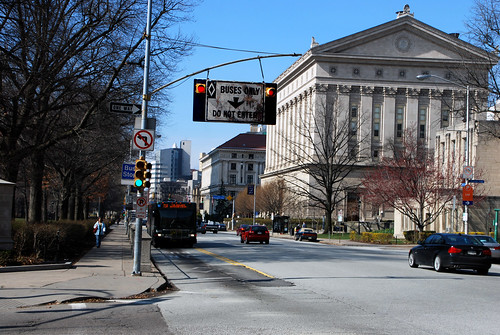
Contraflow bus lane in Pittsburgh.
In its report, WMATA also studied bus lanes on both H and I Streets, as well as a traffic management alternative that wouldn’t provide bus lanes, but would optimize traffic signals for buses. All the alternatives improved bus travel, and all of them either improved or maintained current car travel. But the H Street contraflow alternate provided the best combination of benefits, for relatively low cost.
Ultimately DC owns these streets, so the decision to actually implement bus lanes on them rests with the District, not WMATA. But Metro’s report could push DDOT to begin its own study process.
Seems like a good idea.
 Cross-posted at Greater Greater Washington. Cross-posted at Greater Greater Washington.
Average Rating: 4.9 out of 5 based on 155 user reviews.
November 14th, 2013 | Permalink
Tags: bus, roads/cars, transportation

|
Media





Site
About BeyondDC
Archive 2003-06
Contact
Category Tags:
Partners
|



























